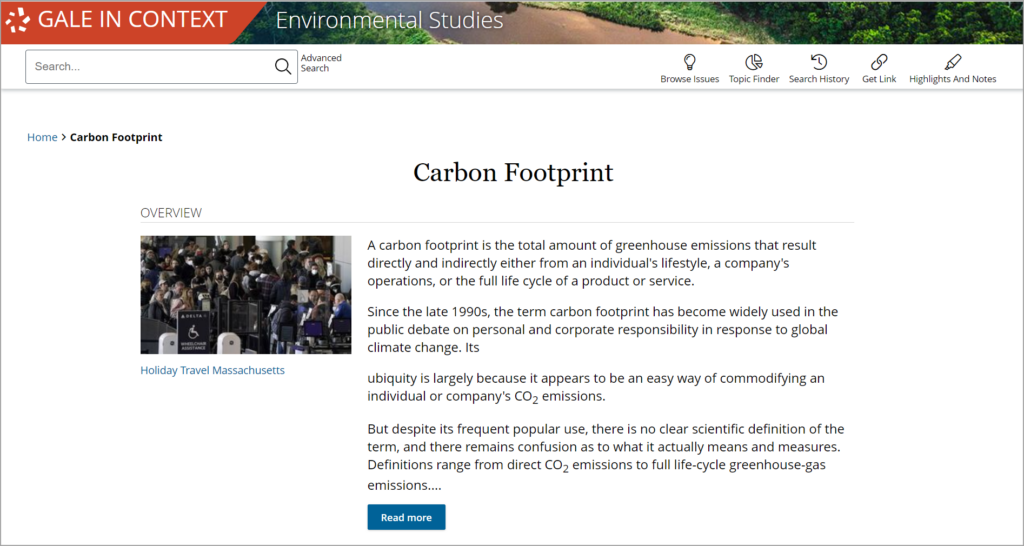| By Gale Staff |
April hosts Earth Day and Arbor Day, and June boasts World Oceans Day and World Environment Day. While these holidays lend themselves well to sunny springtime observations, the crucial lessons they inspire could get forgotten over summer break. Why not reinvigorate environmental awareness with a sustainability celebration in the fall to help care for our planet all year round?
Introducing Sustainability Day! Held on the last Wednesday of October, Sustainability Day presents an opportunity to add conservation habits into your daily classroom routines. It’s also a chance to broaden your students’ curiosity and appreciation for the world around them. Before getting swept up in the winter holiday season, integrate Sustainability Day into your classroom. Develop a sustainability plan or sign a pledge with your students. There are plenty of fun, impactful ideas to set students up with healthy eco-habits.
Make Gale In Context: Environmental Studies your Sustainability Day secret weapon. Full of articles, videos, podcasts, and helpful information, high school teachers can effortlessly develop lesson plans and activities for their classrooms.
Choose a Sustainability Day Theme
When it comes to the topic of sustainability, there are so many directions that educators can take. Start with the sustainability summary page outlining a general definition of the term and significant trends. Sustainability is the concept that humans can manage resources to meet their survival needs but sustain those valuable resources for future generations. It’s a broad term that applies to all aspects of modern society, from water consumption to agricultural land use, fossil fuels, and endangered species.

Use Environmental Studies to select a more focused resource theme for Sustainability Day. For example, teachers in states often facing drought conditions or water use limitations could build a lesson plan using our water scarcity portal while teachers in areas where many students’ families farm could instead discuss sustainable agriculture. Find similar collections for renewable energy and greenhouse gas emissions. Each resource contains thousands of related news articles, academic journal entries, and multimedia content.
Activity Idea: Turn Sustainability Day into Sustainability Week. Select a different theme for each day of the week culminating in a class pledge activity on Friday. Students can develop an individual sustainability commitment for the year using the information they’ve learned throughout the week. Encourage them to share their personal pledge and create a classwide display.
Meet the Heroes of Sustainability
Ordinary people and small changes make a big difference. Introduce your class to the people behind the sustainability movement. Learn about the diverse individuals who enacted significant policy changes or inspired a generation to consider the environment around them.
Take Rachel Carson, an early 20th-century writer, and biologist who helped identify the inherent connection between humans and nature. Her work, Silent Spring, introduced people to the idea that humans have an ethical responsibility to care for the environment around them. Many credit her work as a spark for the modern-day environmental movement.
As another example, your students are undoubtedly familiar with Greta Thunberg, who, at just 16 years old, was nominated for the Nobel Peace Prize for her activism. Your students don’t have to write a book or sail across the Atlantic Ocean. Still, they’ll recognize their potential when they learn the stories of regular people who fought for climate justice and environmental protection.
Activity Idea: The week before October 25, assign students a biographical research assignment. Ask them to select an individual who has advocated for or helped develop solutions for sustainability. On Sustainability Day, welcome students to present on the person they chose.
Practice Meaningful Change
The concept of sustainability provides valuable content for high schoolers to learn but consider ways in which they could put that knowledge into action. We must establish a tangible baseline to create meaningful change. For example, identify your town’s closest waste management facility and discuss the many environmental hazards that landfills pose. As a class, weigh your daily trash output and track it for one month to ascertain the group’s waste footprint.
Once you’ve captured a baseline, celebrate Sustainability Day by developing real goals as a class. Discuss your average waste output and brainstorm strategies to minimize trash. How might your students reduce their impact on the local landfill? Showcase how small individual efforts can evolve into meaningful collective change.
Activity Idea: Introduce the concept of a carbon footprint and ask students to measure their personal carbon footprint. These types of tools provide users with actual data. Metrics like this can help generate personal accountability regarding sustainability.

Decode Greenwashing
Sustainability is a popular concept, and many businesses have implemented positive new practices to make themselves more marketable for eco-minded consumers. Sustainable fashion, organic foods, and upcycling are all popular steps that people take. However, some organizations leverage the sustainability trend without making actual efforts; they spin information to make their products seem sustainable. This misguided marketing ploy is called greenwashing; your high school students have undoubtedly experienced it.
Teachers can direct students to encyclopedia entries and related articles about greenwashing from trusted media sources. Your teenage learners can dive into more nuanced topics like marketing ethics and misinformation. Have them consider whether or not companies should be held financially liable for misleading consumers via greenwashing techniques. Young consumers are inundated daily by ad campaigns and marketing ploys; encourage your students to become savvy, environmentally conscious consumers.
Discussion Idea: Have your high schoolers find an example of greenwashing, whether through social media, television ads, or their own shopping experience. There are countless examples, especially among big-name brands. Facilitate a discussion of what they’ve learned. How can they be more mindful consumers?
There are many ways to approach sustainability. Use the information in Gale as a catalyst for goal setting. As a class, identify small but meaningful ways the school could become more sustainable. You could fundraise for recycling bins, research opportunities for a solar installation on the roof, or establish a community garden on campus. Draft a letter to your school’s administrators asking them for support. Who knows—you could get nominated as a U.S. Department of Education Green Ribbon School.
Introduce positive sustainability habits early this school year. As a class, your combined efforts make an even more significant impact. To start, lean on the user-friendly resources in Gale In Context: Environmental Studies.

